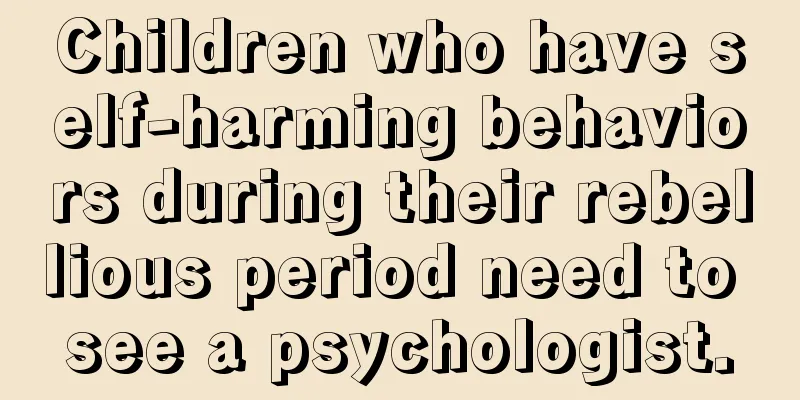What are the dangers of blowing your nose? In severe cases, it can cause otitis media and lead to deafness

|
When babies catch a cold, some mothers see their babies have a runny nose and sometimes sniffle the nose, so they want to blow it for them. However, if the method of blowing the nose is not appropriate, it will harm the baby's health. The following is a look at the harms of blowing the nose. In severe cases, it can cause otitis media and lead to deafness. What are the dangers of blowing your nose?Blowing your nose hard creates a lot of pressure, which can cause headaches or even rupture your esophagus. If you feel your nose is blocked or runny, the subconscious reaction is to grab a tissue or handkerchief and blow it hard. But do you know how to blow your nose correctly? Did you know that when you blow hard, it actually does more harm than good? It can even make your cold worse? Recently, David King, a senior lecturer at the University of Queensland, published an article pointing out that you may be blowing your nose in the wrong way, and this habit can harm you. The harm of improper nose blowing: blowing too hard can cause structural damage But while extremely rare, David King points out that there are examples in the medical literature of people blowing their noses hard enough to create enough pressure to cause serious damage. In most of these cases, people had chronic sinusitis or structural damage from blowing their noses too hard. These injuries include fractures in the floor of the eye socket; air forced into the tissue between the two lobes of the lung; severe headaches caused by air being forced into the skull; and even ruptures in the esophagus. One study looked at the pressure generated when people with and without nasal voices blew out their noses. People with chronic sinusitis generated much higher pressures than those without nasal voices, up to 9,130 Pascals. The researchers also found that blowing your nose by blocking both nostrils at the same time generated much greater pressure than blowing through one nostril. Another study compared the pressure of blowing your nose, sneezing and coughing. The results showed that the pressure generated when blowing your nose was ten times higher than the pressure generated by the other two actions. More worryingly, the study also found that after blowing vigorously from the nose, sticky fluid entered the sinus cavity. Researchers believe that this may be a process that causes viral infection and makes colds more complicated because nasal bacteria are "mixed" in the sinuses. However, researchers have not yet proved this. Overall, repeated, vigorous nose blowing may pose more risks than benefits, even though it seems to be a normal response to a stuffy nose. In severe cases, it may cause otitis media and lead to deafnessDuoduo caught a cold and had a runny nose. At first, when her mother blew her nose, Duoduo was quite obedient, but after a few days, she turned around and ran away whenever her mother wanted to blow her nose. These two days, her mother found that every time she called Duoduo, she had to walk to her side before she responded. After trying several times, she found that her daughter's hearing was really a problem, so she quickly took Duoduo to the hospital. It turned out that every time her mother blew her nose, she pinched the two sides of her nose with a tissue to blow her nose. Every time Duoduo blew her nose hard, the mucus flowed back from the posterior nasal opening and reached the Eustachian tube, which caused otitis media. Later, she did not receive timely treatment, and now her hearing has been seriously affected, which is irreversible! The Myth of Blowing Your NoseBlowing both nostrils at the same time can easily lead to rhinitis. Many people like to hold a tissue and blow both noses at the same time when blowing their noses. This practice not only prevents the nose from being completely cleared, but also poses a health hazard. Because the nasal cavity and sinuses are connected, blowing the nose at the same time can easily cause nasal reflux, allowing bacteria and viruses to retrogradely infect, increasing the risk of acute sinusitis. The correct way to do it is: first press one nostril, blow the other with a little force, and then switch to the other side to ensure that the air pressure on both sides of the nasal cavity is balanced to prevent retrograde bacterial infection. If a cold causes severe catarrhal symptoms such as runny nose, it is recommended to rinse the nasal cavity repeatedly with clean water to help alleviate the condition. Sucking your nose hard will slow down your recovery. Some people are used to sucking back their nasal secretions, but this is not advisable. First, there is a large amount of mucus protein in the nasal and pharyngeal secretions, which blocks harmful substances such as bacteria, viruses and dust. These substances should be expelled from the body instead of being sucked back in. Second, when sucking back in, mucus may enter the trachea by mistake, causing suffocation, which is very dangerous. If you have a runny nose, you must clean it up.If there is mucus in the nose, it is best to clear it out immediately, by blowing your nose gently or cleaning one nostril at a time, using appropriate therapy to reduce the frequency and intensity of blowing your nose, or using a certain amount of pressure to clean your nose. Repeated nose blowing may cause you to develop certain nasal diseases, such as hay fever or sinusitis, which require comprehensive treatment. If you see a child with a runny nose on the street, wipe his/her nose immediately. How to blow your baby's nose correctlyThe mother should take a clean and soft handkerchief or toilet paper and place it on the baby's nose. First, press one side of the nose with her fingers to block the nasal cavity on that side. Let the baby close his mouth and blow out the snot on the other side with force. Then use the thumb and index finger to align from both sides of the bottom of the nostril to the middle and wipe the snot clean, alternating between the two sides. |
<<: What should you pay attention to when you are pregnant if you have allergies?
>>: How to check for diarrhea in children? Five steps to pay attention to
Recommend
How to prevent premature birth? 5 things expectant mothers should do
Premature babies are weaker than normal babies. T...
What are the things to pay attention to during pregnancy? What nutrients should be supplemented during pregnancy?
After a girl becomes pregnant, she usually needs ...
The most complete and detailed maternity bag list in history, you can’t go wrong by buying according to it!
For new mothers, what should they bring before go...
What to do if your baby cries in the middle of the night? Reasons why your baby cries in the middle of the night
Many parents are troubled by their newborns cryin...
Can pregnant women drink corn juice? It is good for intestinal health
Pregnant women can drink corn juice. Corn juice i...
Can I open the windows during the dog days of summer? Can I open the windows during the summer?
The most taboo thing during confinement is blowin...
What is the difference between Vinda's cored and coreless toilet paper rolls? Which one is more cost-effective to buy from Vinda?
Vinda tissues come in two types: cored and corele...
Will I have a stomachache if I conceive successfully? What are the signs of successful conception?
After having sex, many female friends start to wo...
What to do if your newborn baby always hums when sleeping
It is not easy for a newborn to sleep, and mother...
Which nursing bra is better? How to prevent breast sagging during breastfeeding?
Wearing a bra during breastfeeding can prevent br...
Does pregnancy affect memory? There is evidence that pregnancy makes people stupider
There is a saying among the people - "pregna...
What foods are good for children with myopia to prevent myopia from getting worse?
Nowadays, the age group with vision problems is g...
Devondale milk powder price Devondale milk powder is very affordable
Nowadays, better milk powder is still relatively ...
Does drinking coffee during pregnancy affect the fetus?
Coffee is a drink that many people like very much...
Which country's brand is Sensodyne toothpaste from? How to distinguish the authenticity of Sensodyne toothpaste?
The brand of toothpaste, Sensodyne, is also commo...









